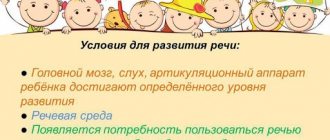"The Magic World of Checkers"
This game also develops in children qualities that are important for their future life, such as the ability to think independently and bear responsibility for decisions made, and to deal adequately with failures and defeats. Moreover, work in a circle involves joint activities of children, which improves communication skills, fosters a friendly attitude of children towards each other, thereby creating a favorable emotional background in the group.
I recommend starting to teach children how to play checkers in the senior group of kindergarten (from 5 years old). It is at this age that children’s attention becomes more stable and voluntary, and the prognostic and visual-imaginative functions of thinking
, which allow us to solve more complex problems. By the age of five, children become more diligent (they can engage in one activity for 20–25 minutes) and are able to play according to established rules.
When learning to play checkers, first of all, it is important to know that children should never be forced, they must want it themselves. In the group there will always be active and curious children who love “something new”; first they get involved in the work, then other children, looking at them, also begin to get involved in playing checkers.
The main thing is that the learning process for children is unobtrusive and interesting. It is necessary to introduce children to material that is new to them in a simple and very accessible form for them to understand. For example, you can tell children about the rules of the game of checkers in the form of a fairy tale or in a poetic version, which, having memorized, children will quickly begin to navigate them and stop getting confused (the most common mistake is moving back with a simple checker in the absence of “safe” moves forward).
The rules of the game of checkers at first glance seem simple, but, as my experience of working with children shows, to play checkers it is not enough just to know the rules, since this game contains many different kinds of difficulties, subtleties and intricacies. In order for children to learn how to play checkers well, they need systematic lessons that contain a minimum of theory and a maximum of practice.
Introducing and teaching children to play checkers occurs in stages, according to the principle: from simple to complex
. First, children need to be introduced to the history of this game, then shown the board, black and white chips, and then taught how to correctly place checkers on the playing field, explain why all checkers are placed only on dark squares (this is necessary so that opponents’ checkers met in the game) and so on. It is also necessary to clearly formulate the essence of the game, which is to, when moving your checkers forward, destroy your opponent’s checkers or block all his moves. After children have learned general information about checkers, they can begin to learn the basic rules of the game. I offer my own poetic version, which greatly helps children quickly master the rules of this smart game.
Special rules for holding a competition in Russian checkers
Rules for the open city championship in playing Russian checkers among children of preschool and/or primary school age
The memo contains the rules for holding a city competition in Russian checkers among preschoolers and/or junior schoolchildren who do not have sports training in this discipline (amateurs). This leaflet is compiled on the basis of the rules of the sport “checkers”, approved by the order of the Ministry of Sports of the Russian Federation (hereinafter referred to as the Order) dated April 26, 2022 No. 347, in particular clause 6.1. "Russian checkers". The main differences from the rules for holding sports tournaments are that the competition (Championship), the method of organization of which is described in the memo, is held without applying the rule on impossible moves, without replay in case of a draw, and also without the use of chess clocks and specialized programs for selecting opponents with determining the sides of the board (checker colors). The proposed rules were successfully tested by the author of the memo when organizing numerous amateur competitions in Russian checkers on the basis of the UDO chess and checkers association.
1. General Provisions.
Participation in the Championship is free
for players and their leaders (parents/legal guardians and/or teachers).
The organizers of the event, the judge and his assistant(s) during the preparation and conduct of the Championship are guided by the rules of the sport “checkers”
, approved by the order of the Ministry of Sports of the Russian Federation (hereinafter referred to as the Order) dated April 26, 2022 No. 347, in particular clause 6.1. "Russian checkers".
Participants of the Championship and their leaders (parents/legal representatives and/or teachers) must be familiar with
with the above-mentioned regulatory document (Order), including its parts and paragraphs directly related to the rules of the game
of Russian checkers
, as well as the rules of behavior of players and spectators during games and breaks.
Participants of the Championship compete in the individual competition
, demonstrating in practice the gaming skills and abilities in the sports discipline “Russian checkers” that they had developed at the time of the event.
The competition is held according to the Olympic system
, when players who were
defeated
in any of the games
are eliminated
from further participation in the Championship, and those who drew, as well as those who won, move on to the next round.
2. Principles of drawing lots and selecting opponents.
Before the start of the first round, participants are divided into playing pairs in accordance with the numbers received during registration, according to the principle “No. 1 - No. 2, No. 3 - No. 4,” etc. (with the exception of participants speaking from one educational institution who registered consecutively; in this case they meet with students from another educational institution, whose numbers follow further on the list). In subsequent rounds, playing pairs are drawn up on the principle of matching the closest numbers that have not been eliminated at one board.
In accordance with the rules for conducting competitions in Russian checkers regulated by the Order, in all rounds pairs of participants are composed in such a way that any of the players meets a new opponent each game. However, some participants in extreme cases (for example, when a replay is scheduled) may meet at the same board again.
If there is an odd number of participants at any stage of the competition, one of the players who has not been paired with an opponent automatically (early) moves on to the next round
.
In this case, any of the participants, when pairing players, only once, by the decision of the judge,
be left without an opponent and, therefore, advance to the next round early. Typically, such participants are players occupying the extreme rows of the tournament table.
In accordance with the rules of the competition regulated by the Order, the colors of the checkers before the start of the first game are assigned to the participants according to the principle “odd numbers play with white.” In subsequent games, the color of each player's checkers changes to the opposite (the participant who previously competed with white sits on the black side, and vice versa). If in the previous game both players owned the same color (in different pairs), its change is determined by drawing lots, and the right to draw lots is always granted:
- to a girl;
- the youngest number for gender equality.
In accordance with the rules of the competition regulated by the Order, in some cases some participants can play up to 4 times in a row with checkers of the same color.
3. Rules for conducting a game.
Due to the age of the participants, the competition is held without counting impossible moves.
, entailing in professional (sports) tournaments the automatic (early) awarding of defeat to a player when he performs an erroneous action on the board once (in some cases, twice or three times) that does not comply with the game rules.
In accordance with the rules of conducting a game in Russian checkers regulated by the Order, the participant has the right not to notice the opponent’s mistakes
(in your favor).
In accordance with the rules regulated by the Order on making a move (including capturing) in Russian checkers, during the game it is unacceptable:
a) cancel an action completed by the player
on the board, even by agreement with the opponent.
An action (move) is considered completed if the participant has moved any checker that belongs to him and is in the game (simple or king) in any way that does not contradict the rules and has taken his hand away from it. In this regard, players, if possible, should not allow
accidental or intentional
touching of
checkers on the board, both their own and those of others. In case of repeated violation of the touch rule, including complaints from the opponent, the referee can reprimand the player (in the first officially recorded case), issue a warning (in the second officially recorded case) or force him to make a move with the last touched checker (in the third, fourth and further officially recorded cases);
b) perform an action such as “fuk”
- removing an opponent’s checker (simple or king) from the board when he makes a mistake in the game, most often when skipping a move and taking one or more simple checkers and/or kings. If the opponent makes this mistake, the participant either points out it to the co-player and asks him to correct it, or ignores it (usually in his own favor), or calls the judge with his raised hand and follows his instructions.
c) in case of multiple capture - hit any number of checkers at will. According to the rules, if in one move a simple or king can “cut down” several (2, 3 or more) undoubled checkers (simple and/or kings), the player is obliged to take them all, even if it is unprofitable for him. In the diagram below (left), the white queen must hit the simple checkers in the direction of the arrow, thereby falling into a trap; she cannot beat double queens.
At the same time, in the diagram on the right, White has the right to choose which way to hit (the advantageous move is indicated by the arrow), and thus avoid the trap. In this case, the opponent cannot force a co-player to make this choice in his favor.
d) move the king from line to line (“zigzag”) during a move without capturing, as well as during capture, if there is no checker on one of the lines that can be captured (see diagrams below: erroneous
moves are marked with an arrow).
e) hit with a checker turned into a king immediately after hitting any square of the extreme horizontal line (see diagram on the left). At the same time, if the transformation into a king was carried out during capture, the checker continues to hit according to the queen rules (becomes a “king on the pass”, see the diagram on the right). Moreover, any lady is not obliged
while capturing,
stop on the next
square
after the captured checker .
false true
f) hit with a checker, a simple or a king (including one turned into a king during capture), through an already beaten simple and/or king of the opponent (in the diagram below, an erroneous
the move is shown by a dotted arrow).
In accordance with the rules of Russian checkers regulated by the Order, a winning situation in the game, in addition to destroying someone else’s material, is to block it in such a way that none of the checkers, in turn, can perform any game action on the board
, including taking. Thus, in the positions presented below, Black is awarded defeat.
At the end of the game, players must remain in place and not move the checkers in the resulting final position
until the judge
recorded the result of
the meeting of these participants in the standings.
If the judge cannot independently verify the reality (correctness and/or veracity) of the outcome of the game reported by the players (for example, when the participants hurried to place the checkers in the starting position after the end of the game),
, including defeat, can be entered into the tournament table for both participants if, when questioned, they report conflicting information about the outcome of the meeting.
For pairs of participants who did not complete the game after 80% of the game boards were completed
a time of 5 minutes
may be assigned to determine the outcome of the meeting in order to comply with the time regulations of the event. Due to the age of the participants, the competition is held without special (chess) chronometers; The time is set using an hourglass. After the expiration of the established time, in case of a protracted game, the judge has the right to independently determine its outcome (draw or victory) by the quantity and arrangement of material (simple checkers and/or kings) remaining on the board for each participant, in accordance with the rules of the Russian checkers competition regulated by the Order . Usually, with a significant advantage of simple checkers and especially kings, even against a lone king, a victory is awarded, except in cases where the game has an obvious continuation and the participant can achieve a win, for which he makes a series of conscious moves aimed at removing the opponent’s material from the board or blocking the opponent’s material (building “traps” ”, sees and uses other people’s mistakes for his own gaming benefit, etc.). Also, a draw can be awarded in the game if the participant with a single king demonstrates attentive and tactically correct play (takes the “high road” with the king and remains on it, does not expose the king to attack for 15 moves, etc.).
If necessary, the Organizers have the right to conduct additional rounds or schedule a replay to more accurately determine the winner(s) and prize-winner(s) of the competition.
4. Rules of conduct during the event.
During games, the presence of accompanying adults (parents/legal representatives and/or teachers) in the audience where the competition is being held is strictly prohibited
. Adults wait for competition participants in the foyer and are invited by the judge to the “tournament hall” only in special cases.
During a competition, its participants and the adults accompanying them (parents/legal representatives and/or teachers) do not have the right to suggest moves to players, point out mistakes, or apply any psychological pressure, including forcing them to perform actions on the board faster or create profitable ones. situations in their favor, as well as distract players in other ways (conversations, noise, physical stimuli, etc.). If these rules are repeatedly violated by the participant himself, sanctions may be applied to him by decision of the judge, up to exclusion from the Championship if warnings are issued repeatedly (in accordance with the rules of the competition regulated by the Order); a remark is made to the participant's leader(s).
The referee and/or his assistant(s) at any stage of the event cannot interfere in any way with the participants’ games (do not give advice, do not correct noticed errors, do not resolve conflicts between opponents, etc.) without the express desire of the players themselves . Participants express their desire to seek assistance from the judge and/or his assistant(s) by raising their hand.
These rules are strictly for familiarization and compliance by all parties involved in the Championship.





